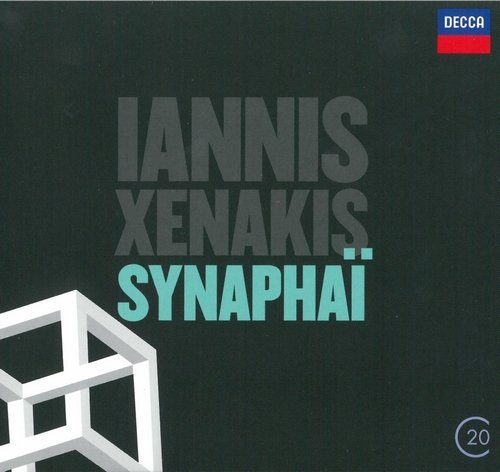
Elgar Howarth, Claudio Abbado - Iannis Xenakis: Synaphaï (2013)
BAND/ARTIST: Elgar Howarth, Claudio Abbado
- Title: Iannis Xenakis: Synaphaï
- Year Of Release: 2013
- Label: Decca
- Genre: Classical
- Quality: FLAC (image+.cue,log,scans)
- Total Time: 01:00:12
- Total Size: 349 Mb
- WebSite: Album Preview
Tracklist:
1. Synaphaï for piano and orchestra
Geoffrey Douglas Madge, piano
New Philharmonia Orchestra
Elgar Howarth
2. Aroura for string orchestra
New Philharmonia Orchestra
Elgar Howarth
3. Antikhthon ballet for orchestra
New Philharmonia Orchestra
Elgar Howarth
4. Keqrops for piano and orchestra
Roger Woodward, piano
Gustav Mahler Jugendorchester
Claudio Abbado
1. Synaphaï for piano and orchestra
Geoffrey Douglas Madge, piano
New Philharmonia Orchestra
Elgar Howarth
2. Aroura for string orchestra
New Philharmonia Orchestra
Elgar Howarth
3. Antikhthon ballet for orchestra
New Philharmonia Orchestra
Elgar Howarth
4. Keqrops for piano and orchestra
Roger Woodward, piano
Gustav Mahler Jugendorchester
Claudio Abbado
In 1968 the choreographer George Balanchine made a ballet from two works by Xenakis Metastaseis and Pithoprakta and the following year he commissioned Xenakis to compose an original score for New York City Ballet. Antikhthon turned out to be one of the great might-have-been collaborations: Xenakis completed the score in 1971, but the work was never staged. The concept of Antikhthon Anti-Earth or Counter-Earth was first proposed by the Pythagorean philosopher Philolaus of Croton around 400 BC. He speculated that there was a Counter-Earth a hypothetical heavenly body that revolved with the earth around a Central Fire. This led to Philolaus being credited as one of the first to propose that the Earth was not the centre of the universe, but that it was in an orbit around the Sun (Central Fire), with the other planets.
This idea clearly appealed to Xenakis as the basis for a stage work, though his score has no programme and no scenario. Presumably he intended the notion of the Counter-Earth, and the Central Fire (which he called a beneficial source of creative energy ... a mysterious and unknown source which is still beyond mans conception) as something that would stimulate Balanchines choreographic imagination. Certainly, he regarded music as having something of the same intangible qualities as then Central Fire, but he was more pragmatic about what he thought ballet could achieve: being based on what it was possible for the human body to do, he believed that it was limited to the movements we can make with our limbs, our trunk and our head and thats all. The vocabulary of ballet ... is not rich.
The work plays continuously but falls into five distinct sections perhaps reflecting its original intention as a ballet. The first is dominated by sustained clarinet notes and clusters, interrupted by rapid brass chords, a side drum, and nervous, energetic woodwind chords. The second section is driven by rhythmic string patterns (often played col legno), interrupted by increasingly urgent and extended outbursts from woodwind, brass and timpani, which then gradually fizzle out. The short third section (with wind and brass to the fore) prepares the way for the fourth, and longest, section in which initially delicate glissandos in the strings are periodically disturbed by the wind and brass, the strings seeming to feed off these interruptions, becoming increasingly animated and frenetic. The final section is more sustained, leading to a magical, evanescent close.
This idea clearly appealed to Xenakis as the basis for a stage work, though his score has no programme and no scenario. Presumably he intended the notion of the Counter-Earth, and the Central Fire (which he called a beneficial source of creative energy ... a mysterious and unknown source which is still beyond mans conception) as something that would stimulate Balanchines choreographic imagination. Certainly, he regarded music as having something of the same intangible qualities as then Central Fire, but he was more pragmatic about what he thought ballet could achieve: being based on what it was possible for the human body to do, he believed that it was limited to the movements we can make with our limbs, our trunk and our head and thats all. The vocabulary of ballet ... is not rich.
The work plays continuously but falls into five distinct sections perhaps reflecting its original intention as a ballet. The first is dominated by sustained clarinet notes and clusters, interrupted by rapid brass chords, a side drum, and nervous, energetic woodwind chords. The second section is driven by rhythmic string patterns (often played col legno), interrupted by increasingly urgent and extended outbursts from woodwind, brass and timpani, which then gradually fizzle out. The short third section (with wind and brass to the fore) prepares the way for the fourth, and longest, section in which initially delicate glissandos in the strings are periodically disturbed by the wind and brass, the strings seeming to feed off these interruptions, becoming increasingly animated and frenetic. The final section is more sustained, leading to a magical, evanescent close.
Classical | FLAC / APE | CD-Rip
As a ISRA.CLOUD's PREMIUM member you will have the following benefits:
- Unlimited high speed downloads
- Download directly without waiting time
- Unlimited parallel downloads
- Support for download accelerators
- No advertising
- Resume broken downloads


